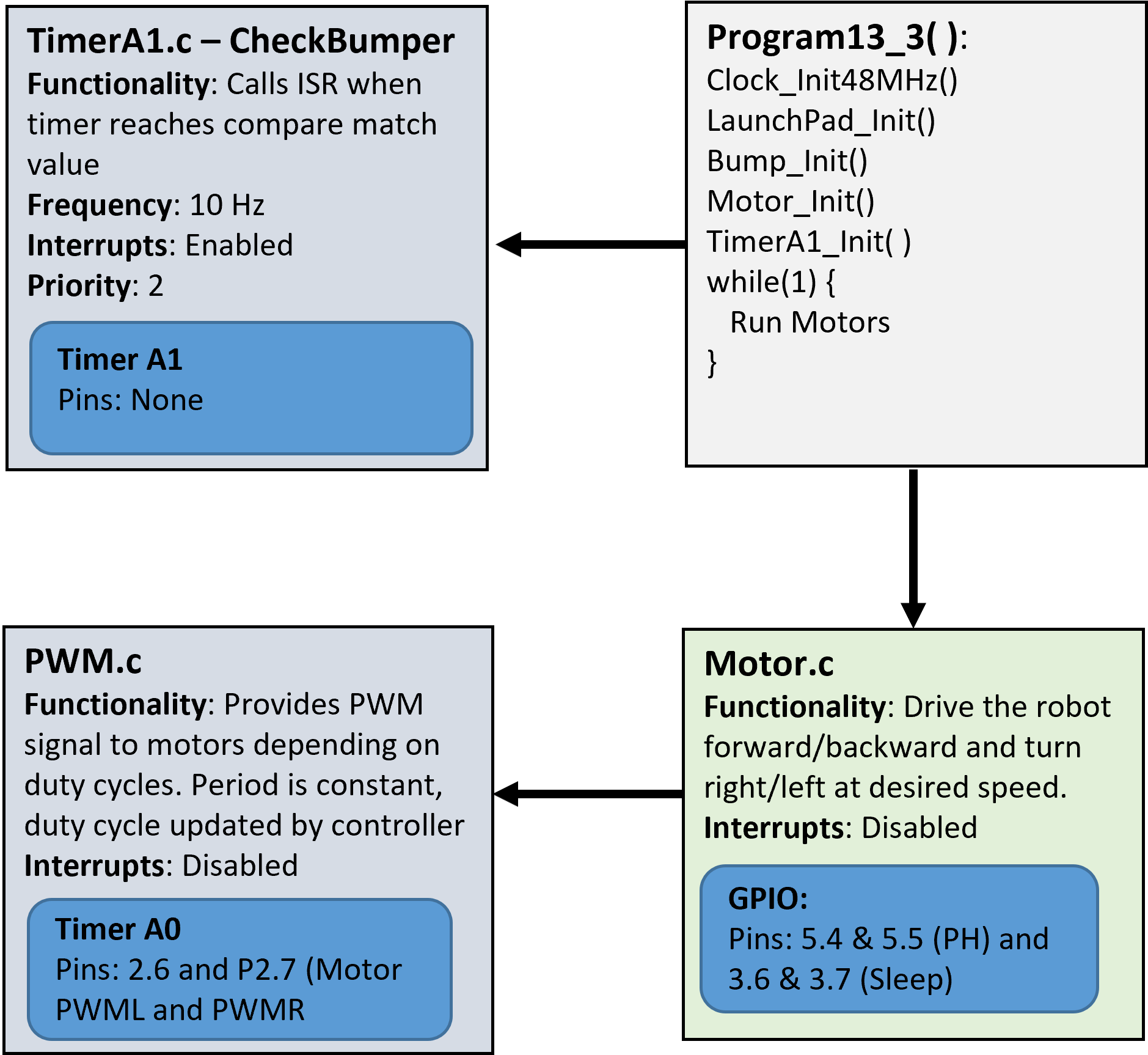🔬 Lab 13 Timers#
📌 Objectives#
Students should be able to write software module that generates periodic interrupts to run user-specific tasks.
Students should be able to generate PWM signals using a timer module.
Students should be able to use PWM outputs to adjust the motor speeds.
Note
Make it work, make it right, make it fast. – Kent Beck
📜 Synopsis#
This lab aims to write software that can adjust the applied power to the two motors. You will create PWM outputs on the P2.6 and P2.7 pins connected to the EN pins of the two TI DRV8838 motor drivers. The period of both PWM outputs should be fixed at 20 ms (50 Hz). However, the software should be able to independently set the duty cycle of the EN pin to each motor from 0 to 999 (0 to 99.9%). At 50 Hz, the motor will not respond to individual highs and lows; instead, the motors will respond to the average level. More specifically, the delivered power will be:
where \(V\) is the voltage, \(I\) is the current, and \(d \in [0, 99.9]\) is the duty cycle in percent (%).
Duty cycles are typically expressed as a percentage of ON time, which is a real number between 0.0% and 100.0%. However, in microcontrollers, it is preferable to avoid floating point numbers and their computations. Therefore, we will use a 16-bit integer between 0 and 1,000 to represent a duty cycle between 0.0% and 100.0%. We will use the unit permille, which means one out of every one thousand (mille). Another advantage of using permille is that we can express 1,000 different values using a 16-bit integer, whereas we can only have 100 different integer values if we use a percentage.
💻 Procedure#
Setup#
Before proceeding, review the solution for TimerA1_Init posted on Gradescope to confirm you have the accurate code. If the solution isn’t available on Gradescope, consult your instructor to go over your code.
Write Timer functions in TimerA1.c.#
Open
TimerA1.handTimerA1.cand read them thoroughly.Carefully examine
Program13_1to understand (i) howTimerA1is initialized and (ii) how the semaphore is employed to coordinate between the foreground and background threads.Write the
TimerA1_Stop()andTA1_0_IRQHandler()functions, as discussed in Lecture 13 and referenced in Valvano’s textbook.Demonstrate
Program13_1as shown in the video below. Ensure that the red LED blins at 5 Hz, the blue LED blinks at 2.5 Hz, and the LCD updates the elapsed time at a rate of 5 Hz. Your demo should also show the timer interrupt being enabled by pressing a switch and disabled by pressing a bump sensor.
Video Credit: C24 Chanon Mallanoo
Important
Why do we employ a function pointer?
We want to enable interrupt service routines to execute a range of user-defined tasks without the need for rewriting them each time a new task arises. As an illustration, when we have different tasks for TimerA1 to execute, we don’t have to rewrite the TimerA1.c file. Instead, we can create functions that carry out these tasks and simply pass their addresses to TimerA1.
Write functions in PWM.c and Motor.c.#
Thoroughly review the documentation provided in
PWM.handPWM.cto understand the functions you will implement.Note that the PWM period for both motors is set at 20 ms (50 Hz). When calling
PWM_Init34fromMotor.c, you should use a period value of 15,000, corresponding to the PWM period of 20 ms. It is not the Timer period, as explained in Lecture 13 Slide 17.Keep in mind that the duty cycles passed into
PWM_DutyRightandPWM_DutyLeftare in permille. The code handles the conversion to the Timer period, so you don’t need to perform this calculation when calling these functions in Motor.c.Read
Motor.handMotor.cthoroughly.Implement the functions in
PWM.cto generate two PWM outputs controlling the robot’s wheels. Both PWM signals operate at 50 Hz (20 ms).Demo
Program13_2as shown in the video below. Use motor functions defined inMotor.cto maneuver the robot and ensure you run at least one iteration in the while loop.
Video Credit: C26 Peter Choi, Royal Military College of Canada
Write functions in Lab13_Timersmain.c#
Write
Program13_3().Combine the
PWMandTimer_A1periodic interrupt functionality into one software system that controls the robot likeProgram 13.2, but uses the periodic interrupt to track the time elapsed.While the Timer interrupt runs in the background, the foreground thread will display the motor functions on the LCD.
As shown in the component block diagram below,
PWM.cis not directly accessible toProgram13_3; It is encapsulated inMotor.c.Program13_3will only use the functions in Motor.c to control the motors.
Demo
Program13_3as shown in the video below.
Video Credit: C26 Peter Choi, Royal Military College of Canada
🚚 Deliverables#
Deliverable 1#
[6 Points] Demo
Program13_1(). UseTimerA1to blink the red LED at 5 Hz while the blue LED blinks at 2.5 Hz and the LCD updates the elapsed time at 5 Hz. Your demo should also show the timer interrupt being enabled by pressing a switch and disabled by pressing a bump sensor. During the demo, explain what you are demonstrating.
Deliverable 2#
[7 Points] Demo
Program13_2(). Use motor functions defined inMotor.cto move the robot. You must run at least two iterations in the while loop. During the demo, explain what you are demonstrating.
Deliverable 3#
[7 Points] Demo
Program13_2as shown in the video below. Use motor functions defined inMotor.cto maneuver the robot and ensure you run at least two iterations in the while loop. During the demo, explain what you are demonstrating.
Deliverable 4#
[9.5 Points] Push your code to your repository using git. Write comments in your code.
This lab was originally adapted from the TI-RSLK MAX Solderless Maze Edition Curriculum and has since been significantly modified.
